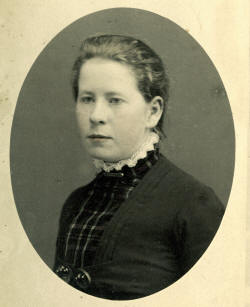

Queer Places:
157 N West Temple, Salt Lake City, UT 84103
Salt Lake City Cemetery, 200 N St E, Salt Lake City, UT 84103
 Kate Thomas (July 2, 1871 – March 5, 1950) was born in Salt Lake City to British parents. She became a prolific, turn-of-the-XX century Mormon playwright and poet who withdrew somewhat from Mormonism while exploring her attraction to other women.
Kate Thomas (July 2, 1871 – March 5, 1950) was born in Salt Lake City to British parents. She became a prolific, turn-of-the-XX century Mormon playwright and poet who withdrew somewhat from Mormonism while exploring her attraction to other women.
She was the daughter of Richard Kendall Thomas (1844–1915) and Caroline Stockdale (1848–1931). She was one of 13 children, sibligns include Frederick Stockdale Thomas (1866–1903), Jessie Thomas (1869–1870), Arthur Frank Thomas (1874–1953), Blanche Kendall Thomas McKey (1879–1973), Maude Thomas( 1881–1885), Elbert Duncan Thomas (1883–1953), Ethel Thomas Bowman (1888–1947), Rodger Kendall Thomas (1889–1967). R. K. Thomas was a prominent retailer, interested in theater. As well as his retailing efforts, he was at one time a choreographer for the Salt Lake Theater for John T. Caine. We can assume that Kate spent some time in her youth minding the family store, but it was the theater, arts, and letters which captured her imagination.
When Kate was 24, her father transformed the family barn into Salt Lake City's first little theater, The Barnacle. The remodeling job was outstanding -- a balcony was created in the hayloft, the stage was built over the horse stalls, and the orchestra pit was the buggy shed. After several puppet shows, and homespun productions which the Thomas children both wrote and performed, The Barnacle caught the attention of the adult theater audience, and the old barn went professional.
Thomas, who never married, left Utah for New York City and Europe in 1901 but still maintained contact with Mormonism by writing lessons and poetry for the Relief Society and Young Ladies’ manuals and magazines while on her extended absences. At the age of nineteen Thomas began keeping a private journal of what she called her love poetry while attending courses in Salt Lake City at the LDS Business College and later the University of Deseret (now the U of U). This journal consists almost entirely of love poems written to other women. Her writing is full of unrequited love for men, and later, an almost sensual passion for women. In them, she sometimes referred to herself as a Gay Musician and used the word gay repeatedly and exclusively in her poems about her desire for women, much as Lesbian writer Gertrude Stein did around this time.
In 1901, when Kate moved to Greenwich Village in New York City, she explored not only Lesbian desire, but also religious and spiritual traditions as diverse as Catholicism and Buddhism – and she also practiced yoga. Some of her poetry of that same period reflects a growing disaffection with Mormonism. Thomas also became an outspoken suffragette, peace activist, anarchist, and supporter of the very controversial League of Nations.
Kate returned to Utah before 1920, living first with her mother, and by 1930 with her brother Elbert, a Democrat who in 1933 would become Utah’s US Senator. At some point her faith in Mormonism was restored enough that when she was 49, she participated in the LDS temple endowment ceremony as a single woman.
My published books: